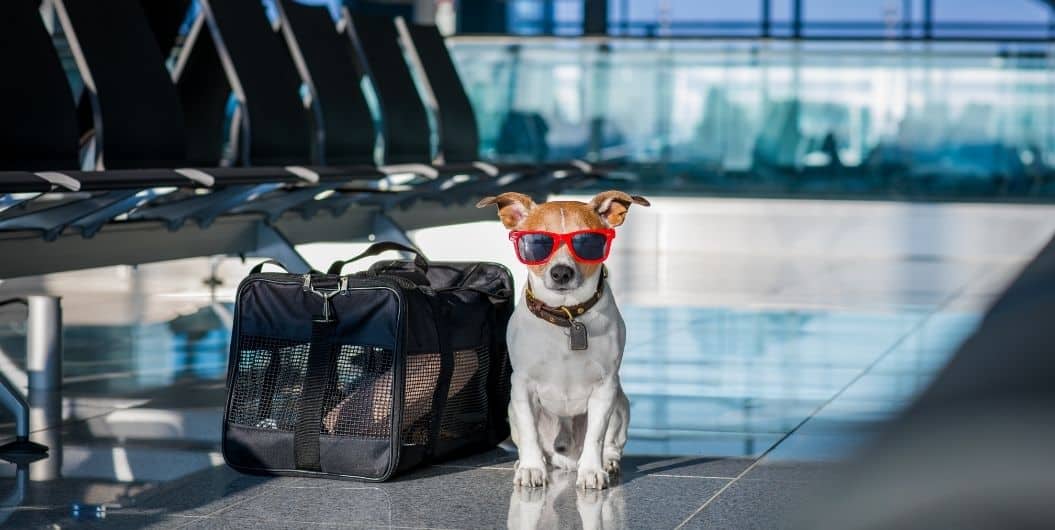Flying With Emotional Support Dog in 2024

An emotional support dog is a necessary part of life for many who cope with mental health struggles. An emotional support animal offers comfort and love to its owner. An emotional support animal, or ESA, doesn’t have to be a dog but can be any animal. Many popular ESAs include dogs, cats, ferrets, and even animals like miniature horses. If you have an ESA you might wonder what all of the different rules are regarding ESAs in public spaces, which can include flying with your emotional support dog. It is a confusing topic because there are many rules regarding emotional support animals, therapy dogs, and service dogs.
What is a Service Dog
When many people hear the words support dog, emotional support animal, therapy dog, or anything along those lines, they might automatically picture a dog in a vest helping their owners each day. A service dog is often what comes to mind for many people, and these dogs will work or perform tasks for a person based on their specific training. While emotional support animals, support animals, therapy dogs, and service dogs are similar in some ways, there are different rules regards each type of working dog’s role.
A service dog is a working dog that helps a person with a disability live with more independence. Because a service dog is individually trained to help a person operate in the best way possible each day, there are different rules and regulations regarding service dogs than other types of support dogs. Service dogs may help their owners perform tasks in everyday life that other types of support dogs would not. There are different kinds of service dogs, including guide dogs, hearing dogs, and mobility dogs. These dogs help a person perform daily tasks by assisting them physically. An emotional support dog helps a person function daily by offering emotional assistance.

What is an Emotional Support Dog
While a service dog assists people by helping them perform daily tasks by offering different types of physical support, an emotional support dog can help its owner in many ways. Sometimes a person might suffer from debilitating mental health struggles that can affect how a person functions in daily life. A person might have a mental health illness that causes negative physical symptoms, severe emotional trauma, or even disruptive behavior. An ESA can help lower blood pressure, calm a person’s nerves, and offer emotional support to cope with an illness. There are many reasons why someone might need an ESA, and here are the most common reasons.
Reasons to Have an ESA
There are many reasons why a person might benefit from having an emotional support animal, and for many, an ESA is a medical need to cope with everyday life, including eating out at restaurants or flying. While a person’s doctor knows their medical history best, some people benefit from the companionship of an ESA in combination with their doctor’s other medical recommendations. There are countless medical reasons why someone would have an emotional support dog, but these conditions are among some of the most common.
Anxiety
Someone with anxiety may experience intense fear, worry, or restlessness. Anxiety can cause other effects as well like fatigue and difficulty concentrating. Anxiety can have a very negative influence on a person’s life. Some people who struggle with anxiety may also choose to limit interactions with other people or avoid situations that cause their anxiety levels to rise. An emotional support dog can help keep a person with anxiety calm by offering a physical presence that can lower stress levels and release feel-good hormones. When a person pets an emotional support dog, it releases hormones that can help them feel calmer which can help when a person takes an airline flight.
Depression
When a person suffers from depression, they will likely experience intense feelings of sadness, changes in appetite, a loss of energy, trouble sleeping, and feelings of worthlessness or guilt. There are many symptoms of depression that negatively affect a person’s life, and an emotional support animal can help someone cope with those symptoms. Emotional support dogs offer companionship and affection that help someone struggling with depression.
Panic Attacks
Panic attacks can cause someone to feel like they’re experiencing sudden and unexplained feelings of fear, panic, or anxiety. These symptoms can come out of nowhere and can accompany physical symptoms. When a person has a panic attack, they might have flushed skin or begin to sweat. They may also experience an increase in heart rate or quickened breathing. These symptoms can negatively affect how a person functions in their life, and an emotional support dog can help.
Chronic Stress
There are many reasons why a person might develop chronic stress, including things in their home life, work-life, or a traumatic event. Major life activities, family stress, or life changes can also lead to chronic stress. This medical affliction is a prolonged and constant feeling of overwhelming stress in a person’s life. Chronic stress can cause digestive issues, high blood pressure, abnormal heart rhythms, and other negative effects on the heart. An emotional support dog can help lower a person’s blood pressure and calm someone struggling with chronic stress.
These mental health struggles can make a person feel hopeless, but emotional support animals can help. Just as service animals help a person cope with daily physical struggles, emotional support animals can help people cope with daily mental health battles. Because emotional support animals can be a medical need for some, owners of ESAs may want to venture out along with their furry friends as emotional support.
Eating at Restaurants with Emotional Support Dogs
When someone is coping with a mental health struggle, they’ll likely want their emotional support animal nearby as often as possible. That way, their emotional support dog can help them cope with mental health struggles because many mental health episodes are often unexpected and unpredictable. While it’s easy for a person to have their emotional support pet nearby at home, some owners may wonder what it’s like to have their pets in public settings, too.
While not all restaurants, airlines, and stores may allow pets or acknowledge an official ESA letter, it’s always a good idea to plan and call establishments before stopping by. Some people feel they can’t go out with their emotional support pet, which is understandable. So instead of avoiding restaurants or stores altogether, ESA owners should call or have someone call the places they want to visit ahead of time.
Many restaurants offer outdoor seating, and they’re often okay with pets sitting outside with restaurant-goers. Bottom-line, the rules for allowing emotional support dogs will vary from place to place, so it’s best to check before going out. But some ESA owners may wonder, are emotional support dogs allowed in no-pet apartments?

Living with Emotional Support Dogs
When a person recognizes that they may need the support of an emotional support animal, they must talk with a licensed medical professional about their needs. After speaking with a mental health professional, the doctor may decide that there is a medical need for them to have an emotional support animal. The mental health professional will then write an emotional support animal letter on behalf of the person, and the person can then show this letter to their landlord.
The landlord must acknowledge this person’s medical need for an emotional support pet and allow the pet to stay on the premises, as well as waive pet fees. When someone has been diagnosed with a medical need to have the companionship of an ESA dog, landlords must acknowledge a person’s official ESA letter. While a landlord is legally obligated to recognize an ESA letter as proper documentation stating a person’s medical need for their animal, airlines do not.
Flying with Emotional Support Dogs
As stated above, emotional support animals help people function with struggles they can experience daily, including stressful situations like flying. But some airlines don’t acknowledge a person’s official ESA letter stating that they have a medical need for an emotional support dog. Rules differ from airline to airline, so it’s always best to call and make arrangements well before a scheduled trip. Airlines no longer consider emotional support pets as a type of service animal, so rules for both of these types of working pets are different.
Rules About Service Dogs on Airplanes
Overall, airlines must allow service dogs to sit in the cabin with individuals with disabilities with the proper documentation. If a service dog poses a safety concern, they’re allowed to deny transport to the pet. Some airlines allow fully-trained service dogs to fly in the cabin with their owners at no charge. Usually, airlines will want service dogs to be harnessed or leashed, well-behaved and clean, and small enough to fit at a person’s feet.
Rules About ESAs on Airplanes
It can be difficult to fly with an ESA because airlines don’t have to accommodate emotional support animals anymore. Because the rules for flying with emotional support dogs are often changing, it’s best to always check in specifically with the preferred airline. If an airline does accept emotional support animals in the cabin, you will still need to fill out the proper paperwork and likely provide your pet’s letter. Generally, airlines require ESA documents to be submitted before the flight, sometimes 48 hours in advance. Most airlines will allow individuals to travel with a checked pet if they do not allow emotional support animals in the cabin of the plane.
Because an emotional support pet is such an integral part of a person’s life and medical journey, it’s always best to call or look online to check specific airline guidelines. The rules vary from airline to airline regarding forms, advanced notice, travel requirements, restricted destinations, and animal behaviors when traveling with a pet.
The rules surrounding emotional support animals and dogs, in particular, have always had a certain amount of elasticity.
When the American Disabilities Act first came out, it made explicit provisions about how and when to accommodate service animals. What the act didn’t anticipate was the rising trend for emotional support dogs, so the rules surrounding them are murkier.
When it comes to traveling with emotional support dogs, those rules have recently changed. Here’s everything you need to know about flying with an emotional support dog.
Do Airlines Have To Accept Emotional Support Dogs on Board?
Unfortunately, the new rules associated with emotional support animals (ESAs) say that if you are flying with an emotional support dog, the choice to let them into the cabin is at the discretion of the airline.
That makes it crucial that when you make your travel plans, you consult with the airline about their in-cabin pets policy before completing your booking.
What if I Bring Documentation With Me?
It’s always wise to have the signed and dated medical letter vouching for your emotional support dog’s status being more than a pet on hand. But that doesn’t guarantee all airlines will agree to let you fly with your emotional support dog.
While they are unlikely to turn your emotional support dog away completely, they may require them to travel in cargo. This can complicate your travel arrangements because different airlines have different rules about which dogs travel in cargo and when.
What Should I Be Aware of if My Dog Is Traveling in Cargo?
Temperature and weather can have a significant impact on your dog’s health. No one wants your dog to be too hot or too cold in cargo, and that’s why many airlines ask you to arrive with a note from the vet saying it’s safe for your dog to fly.
The dog’s breed is another consideration. Most service dogs are Labradors or Golden Retrievers, neither of which give anyone pause when bundling them into cargo. But emotional support dogs come in all shapes and sizes, and that makes a difference.
Airlines are particularly wary of traveling with brachycephalic dogs because their flattened noses can cause problems breathing while flying. If your dog fits this description, it’s imperative you double-check with the airline before trying to fly with your emotional support dog.
Which Airlines Let You Fly With Emotional Support Dogs?
As of January 2021, the current policy of American Airlines is that emotional support dogs are not considered service animals and can only be transported as carry-on pets or cargo pets.
This is in keeping with a policy outlined by the Department of Transport. It will not affect service animals but may make it difficult for you to fly with an emotional support dog.
Are There Exceptions?
The notable exception to the new policy on flying with emotional support dogs concerns psychiatric service dogs.
Psychiatric service dogs are dogs that facilitate life for people with mental health disabilities such as PTSD. It is possible for an emotional support dog to qualify as a psychiatric service dog, but you first need to prove that you cannot live an independent life without the assistance of the dog.
Psychiatric service dogs perform a variety of tasks, including:
- Tactile stimulation
- Deep pressure calming
- Prompting handler to take medication
- Averting self-destructive activities
Irrespective of the dog’s breed and size, if you can show documentation indicating your emotional support dog is also a psychiatric service dog, airlines will let you fly with them in the cabin.
You will not be charged for boarding the plane with a psychiatric service dog.
What if My Dog Is a Service Dog?
Although it’s no longer guaranteed that you can fly with an emotional support dog, the policy regarding service dogs remains unchanged.
You can still fly with a service dog. However, you will need to complete several forms beforehand. Depending on the airline, they may expect you to identify your dog as a service dog by having them wear a vest or harness indicating their purpose.
Before you fly, consult the airline about their policy on animal seating. Some airlines allow your service dog to sit on your lap. Others may insist they stay at your feet or under the seat. For safety reasons, many airlines will not allow you and your service dog to sit in an emergency exit row.
Conclusion
Recent policy changes make it difficult to fly with an emotional support dog. While you may still be able to bring the dog with you, be prepared to put your dog in cargo, and prepare the appropriate travel documents.






